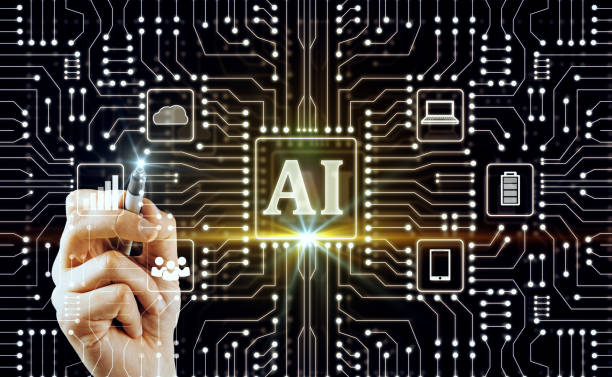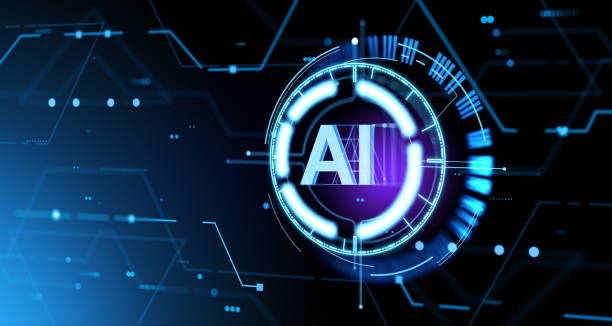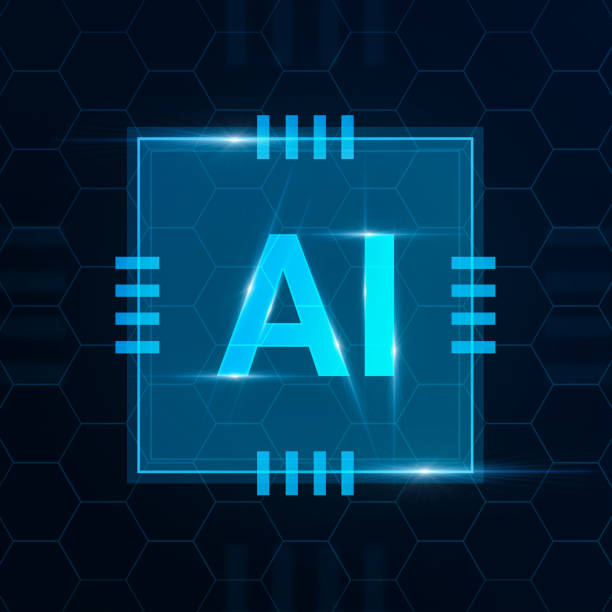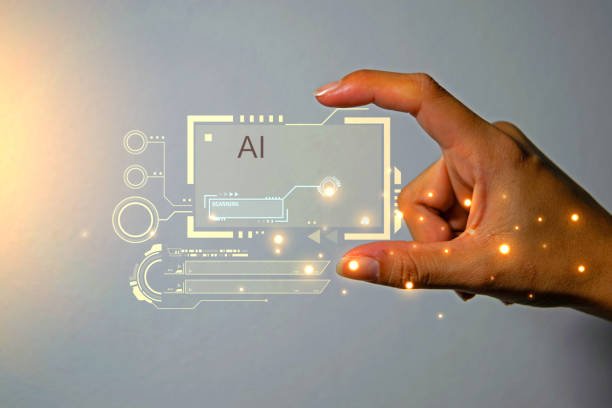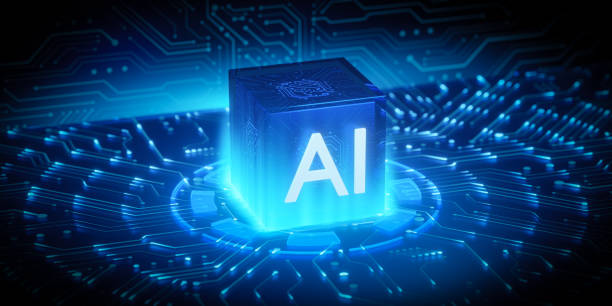### What is Artificial Intelligence? Definition and Basics
#Artificial_Intelligence (#AI) is a branch of computer science that deals with building machines that are capable of performing tasks that usually require human intelligence.
These tasks include learning, problem-solving, pattern recognition, natural language understanding, and decision-making.
The main goal of artificial intelligence is to create systems that can act independently and intelligently.
Artificial intelligence is mainly divided into two categories: Weak AI (Narrow AI) and Strong AI (General AI).
Weak AI focuses on performing specific tasks and performs very well in this area, but is not capable of performing tasks outside of that scope.
Examples of weak AI include voice assistants like Siri and Alexa, movie and music recommendation systems, and facial recognition software.
In contrast, Strong AI refers to a system that has the ability to understand, learn, and perform any task that a human is capable of performing.
Strong AI is still in the research phase and has not been fully realized.
Key concepts in artificial intelligence include Machine Learning, Deep Learning, Neural Networks, and Natural Language Processing.
Machine learning allows machines to learn from data and improve their performance without explicit programming.
Deep learning is a subset of machine learning that uses deep neural networks to analyze data.
Neural networks are computational models inspired by the structure of the human brain.
Natural language processing allows machines to understand and process human language.
Are you losing business opportunities due to an outdated website? With Rasaweb, solve the problem of not attracting potential customers through your website forever!
✅ Attract more high-quality leads
✅ Increase brand credibility in the eyes of customers
⚡ Get free consultation on corporate website design
Widespread Applications of Artificial Intelligence in Today’s World
Artificial intelligence is currently used in many industries and fields.
In the healthcare industry, artificial intelligence is used for disease diagnosis, drug design, and personalized care.
Artificial intelligence-based image recognition systems can analyze medical images such as MRI and CT scans and identify signs of disease.
In the automotive industry, artificial intelligence plays a fundamental role in the development of self-driving cars.
These cars use sensors and artificial intelligence algorithms to understand their surroundings and make decisions about how to move.
Click here to preview your posts with PRO themes ››
In the financial field, artificial intelligence is used for fraud detection, risk management, and providing investment advice.
Artificial intelligence algorithms can identify unusual patterns in financial transactions and prevent fraud.
In the retail industry, artificial intelligence is used to improve customer experience, optimize the supply chain, and forecast demand.
Artificial intelligence-based recommendation systems can suggest products and services related to customer needs.
In addition, artificial intelligence has important applications in other areas such as education, agriculture, and security.
In education, artificial intelligence is used to provide personalized education and assess student performance.
In agriculture, artificial intelligence helps farmers optimize their products and reduce resource consumption.
In security, artificial intelligence is used to detect security threats and protect computer systems.
In general, artificial intelligence, as a transformative technology, is changing the shape of our world.
Machine Learning and Deep Learning: Differences and Similarities
Machine learning and deep learning are two related concepts in the field of artificial intelligence, but there are fundamental differences between them.
Machine learning refers to a set of algorithms that allow machines to learn from data and improve their performance without explicit programming.
Machine learning algorithms can identify patterns and relationships in data and use them for prediction or decision-making.
Deep learning is a subset of machine learning that uses deep neural networks to analyze data.
Deep neural networks are computational models that are inspired by the structure of the human brain and consist of multiple layers of interconnected nodes.
Each layer of the neural network can extract specific features from the data, and these features are transferred to the next layers to identify more complex patterns.
The main difference between machine learning and deep learning is in how features are extracted from the data.
In traditional machine learning, experts must manually extract features related to the problem and provide them to the machine learning algorithm.
While in deep learning, deep neural networks can automatically extract relevant features from the data.
This makes deep learning more suitable for solving more complex problems with more data.
Click here to preview your posts with PRO themes ››
In short, machine learning is a general concept that includes different types of algorithms, while deep learning is a specific approach in machine learning that uses deep neural networks.
Deep learning, due to its automatic ability to extract features, performs very well, especially in fields such as image recognition, natural language processing, and speech recognition.
| Feature | Machine Learning | Deep Learning |
|---|---|---|
| Feature Extraction Method | Manual | Automatic |
| Type of Data Required | Structured Data | Unstructured Data |
| Model Complexity | Low | High |
| Need for Computational Resources | Low | High |
Natural Language Processing: How Machines Understand and Produce Human Language
Natural Language Processing (NLP) is a branch of artificial intelligence that allows machines to understand, interpret, and produce human language.
The main goal of NLP is to create systems that can communicate with humans in natural language and perform tasks such as machine translation, sentiment analysis, text summarization, and question answering.
Natural language processing includes a set of techniques and algorithms that are used to analyze the structure and meaning of human language.
These techniques include Syntax Analysis, Semantic Analysis, and Pragmatic Analysis.
Syntactic analysis examines the grammatical structure of sentences, semantic analysis examines the meaning of words and sentences, and pragmatic analysis examines how language is used in different situations.
One of the important applications of NLP is machine translation.
Machine translation systems can translate text from one language to another.
These systems use machine learning and deep learning algorithms to learn language patterns and translate more accurately.
Another important application of NLP is sentiment analysis.
Sentiment analysis systems can identify the emotions present in the text.
These systems can be used to analyze customer reviews, examine social networks, and evaluate product feedback.
In addition, NLP has important applications in other areas such as voice assistants, chatbots, and question-answering systems.
Voice assistants like Siri and Alexa use NLP to understand voice commands and answer user questions.
Chatbots use NLP to communicate with users in natural language.
Question-answering systems use NLP to understand user questions and provide relevant answers.
Are you unhappy with the low conversion rate of visitors to customers on your online store?
Solve this problem forever by designing a professional online store website with Rasaweb!
✅ Increase visitor to customer conversion rate
✅ Create a great user experience and build customer trust
⚡ Get free consultation
Ethics in Artificial Intelligence: Challenges and Considerations
With the increasing progress of artificial intelligence, ethical issues related to this technology are becoming more important.
One of the main challenges is discrimination in artificial intelligence algorithms.
Artificial intelligence algorithms can make discriminatory decisions based on their training data.
For example, an artificial intelligence-based hiring system may unintentionally favor individuals with a specific gender or race.
Another ethical challenge is privacy.
Artificial intelligence systems often require a large amount of personal data to operate effectively.
Collecting and using this data can raise privacy concerns.
For example, facial recognition systems can identify people’s faces in public places and collect information about them.
In addition, issues related to accountability and transparency are also of great importance.
If an artificial intelligence system makes a mistake, it is difficult to determine who is responsible.
Also, understanding how artificial intelligence algorithms work and make decisions can be difficult.
This makes it difficult to monitor these systems and ensure that they operate fairly.
To address these ethical challenges, it is necessary to establish ethical and legal standards for the development and use of artificial intelligence.
These standards should address issues related to discrimination, privacy, accountability, and transparency.
Also, it is necessary to provide ethical training for artificial intelligence developers so that they can consider ethical issues in the design and development of artificial intelligence systems.
The Future of Artificial Intelligence: Prospects and Possibilities
The future of artificial intelligence is very bright and full of possibilities.
With the increasing progress of technology, artificial intelligence will increasingly penetrate our lives and create huge changes in many fields.
One of the main prospects is the development of strong artificial intelligence.
Strong artificial intelligence can act independently and intelligently and perform tasks that currently only humans are capable of performing.
Strong artificial intelligence can play a fundamental role in various fields such as scientific research, solving complex problems, and creating new technologies.
However, the development of strong artificial intelligence also has its own ethical and security challenges that must be addressed.
Another important prospect is the integration of artificial intelligence with other technologies.
Artificial intelligence can be combined with technologies such as the Internet of Things, augmented reality, and blockchain to create new possibilities.
For example, the integration of artificial intelligence with the Internet of Things can lead to the creation of smart cities and smart homes.
The integration of artificial intelligence with augmented reality can lead to the creation of more interactive and engaging experiences for users.
The integration of artificial intelligence with blockchain can lead to the creation of secure and transparent systems for managing data and transactions.
In general, the future of artificial intelligence is very exciting and full of new opportunities.
By developing this technology responsibly and ethically, we can use its benefits to improve human lives and solve global problems.
Popular Tools for Artificial Intelligence Development: Introduction and Review
To develop artificial intelligence projects, there are various tools and libraries available that help developers to simplify and speed up the development process.
Here, we introduce and review some of the most popular of these tools:
- TensorFlow: An open-source machine learning library developed by Google.
TensorFlow uses graphical computations to execute machine learning algorithms and supports various programming languages such as Python and Java. - PyTorch: An open-source machine learning library developed by Facebook.
PyTorch is very popular among researchers and developers due to its simplicity and flexibility.
PyTorch uses dynamic graphical computations to execute machine learning algorithms and supports the Python programming language. - Keras: A high-level application programming interface (API) for building and training deep learning models.
Keras helps developers to quickly and easily create and train deep learning models.
Keras supports TensorFlow, PyTorch, and Theano as Backend. - Scikit-learn: An open-source machine learning library that is used to perform various tasks such as classification, regression, clustering, and dimensionality reduction.
Scikit-learn supports the Python programming language and has a simple and user-friendly API. - NLTK: An open-source natural language processing library that is used to perform various tasks such as tokenization, stemming, part-of-speech tagging, and sentiment analysis.
NLTK supports the Python programming language and has a wide range of tools and resources for natural language processing.
In addition to these tools, cloud platforms such as Google Cloud AI, Amazon SageMaker, and Microsoft Azure Machine Learning also offer various facilities for developing and deploying artificial intelligence projects.
The Impact of Artificial Intelligence on the Labor Market: Opportunities and Threats
Artificial intelligence is creating profound changes in the labor market.
On the one hand, artificial intelligence can create new job opportunities.
For example, with the development of artificial intelligence, the need for artificial intelligence specialists, data scientists, and machine learning engineers is increasing.
Also, artificial intelligence can increase productivity and efficiency in various industries and, as a result, create new job opportunities in these industries.
On the other hand, artificial intelligence can lead to the loss of some jobs.
For example, with the automation of repetitive and routine tasks, some jobs that are currently performed by humans may be replaced by machines.
This can lead to increased unemployment and inequality in society.
To address these challenges, educational and labor market policies need to be designed in such a way that people can acquire the skills needed for new jobs and benefit from the new job opportunities created by artificial intelligence.
Also, it is necessary to pay attention to issues related to job security and worker support.
Governments and organizations should take measures to support workers who lose their jobs due to automation.
These measures may include providing retraining, providing unemployment benefits, and creating new job opportunities in other sectors of the economy.
In short, artificial intelligence creates both opportunities and threats for the labor market.
By managing this technology correctly, we can benefit from its advantages to improve human lives and create a sustainable economy.
| Area | Impact of Artificial Intelligence |
|---|---|
| Job Opportunities | Creation of new jobs in the field of artificial intelligence and related technologies |
| Automation | Replacing some repetitive and routine jobs by machines |
| Productivity | Increasing productivity and efficiency in various industries |
| Skills | Need for new skills for future jobs |
Is your online store ready to attract maximum customers and sell more? Rasaweb transforms your online business with modern and efficient online store website design.
✅ Increase speed and improve SEO
✅ Excellent user experience on mobile and desktop⚡ Get free online store website design consultation from Rasaweb!
How to Start Learning Artificial Intelligence: Resources and Solutions
If you are interested in learning artificial intelligence, there are various resources and solutions that you can use.
One of the best ways is to participate in online courses.
Various online courses are available on platforms such as Coursera, edX, and Udacity that teach the basics of artificial intelligence and machine learning.
These courses are usually offered by professors from top universities and have quality educational content and practical exercises.
Another way is to study books and scientific articles.
Various books and scientific articles are available in the field of artificial intelligence and machine learning that you can use to learn more advanced concepts and techniques.
Some of the famous books in this field include “Deep Learning” by Ian Goodfellow, Yoshua Bengio, and Aaron Courville, “Pattern Recognition and Machine Learning” by Christopher Bishop, and “The Elements of Statistical Learning” by Trevor Hastie, Robert Tibshirani, and Jerome Friedman.
In addition, you can participate in open-source artificial intelligence projects.
Participating in open-source projects can help you to put your skills into practice and collaborate with other developers.
Also, you can participate in artificial intelligence competitions.
Participating in artificial intelligence competitions can help you to evaluate your skills and compete with other artificial intelligence specialists.
Finally, the most important thing for learning artificial intelligence is constant practice and effort.
With constant practice and effort, you can become an artificial intelligence specialist and achieve success in this field.
Artificial Intelligence in Iran: Current Status and Challenges
Artificial intelligence is developing in Iran, but it still faces many challenges.
One of the main challenges is the shortage of artificial intelligence specialists.
Despite the fact that the number of students and graduates in fields related to artificial intelligence is increasing in Iran, the number of artificial intelligence specialists is still not sufficient.
To solve this problem, it is necessary to invest more in training and educating artificial intelligence specialists.
Another challenge is the shortage of computational resources and data.
Developing artificial intelligence projects requires strong computational resources and a large amount of data.
Given the existing limitations in Iran, access to these resources is difficult for many artificial intelligence developers.
To solve this problem, it is necessary to create appropriate computational and data infrastructure for the development of artificial intelligence projects in Iran.
In addition, issues related to laws and regulations are also of great importance.
Given that artificial intelligence is a new technology, the laws and regulations related to it have not yet been developed in Iran.
This can create ambiguity and uncertainty for artificial intelligence developers and investors.
To solve this problem, it is necessary to develop appropriate laws and regulations for the development and use of artificial intelligence in Iran.
Despite these challenges, there are many potentials for the development of artificial intelligence in Iran.
With proper investment and the removal of existing obstacles, artificial intelligence can be used for the economic and social development of the country.
FAQ
| Question | Answer |
|---|---|
| 1. What is Artificial Intelligence (AI)? | It is a branch of computer science that aims to create machines capable of simulating human intelligence and performing tasks that require human thinking, such as learning, problem-solving, and decision-making. |
| 2. What are the main types of artificial intelligence? | It can be classified into Weak AI (Narrow AI) that focuses on a specific task, General AI that possesses comprehensive human capabilities, and Super AI that exceeds human intelligence. |
| 3. Mention some common applications of artificial intelligence in our daily lives. | Includes voice assistants (such as Siri and Alexa), recommendation systems (such as Netflix and Amazon), self-driving cars, facial recognition systems, and spam filters. |
| 4. What is the difference between Artificial Intelligence and Machine Learning? | Artificial intelligence is the broader concept of creating intelligent machines, while machine learning is a subset of artificial intelligence that focuses on enabling systems to learn from data without explicit programming. |
| 5. What is Deep Learning? | It is a subset of machine learning that uses multi-layered artificial neural networks (deep neural networks) to process data and discover complex patterns, and is used in image and speech recognition. |
| 6. What are the most prominent benefits of artificial intelligence? | Improving efficiency and productivity, automating repetitive tasks, making better decisions based on big data analysis, and developing solutions to complex problems in fields such as medicine and science. |
| 7. What are the main challenges facing the development and deployment of artificial intelligence? | Includes the need for huge amounts of high-quality data, privacy and security issues, bias in data and algorithms, and high development and maintenance costs. |
| 8. Does artificial intelligence raise ethical or social concerns? | Yes, it raises concerns related to privacy, algorithmic bias, job loss due to automation, responsibility for errors committed by intelligent systems, and the need for a regulatory framework. |
| 9. How can artificial intelligence affect the future of the labor market? | It can lead to the automation of some routine functions, but it will also create new jobs that require advanced skills in developing, operating, and maintaining artificial intelligence systems. |
| 10. What are some of the modern or promising technologies in the field of artificial intelligence? | Includes advanced natural language processing (NLP) (such as large language models like ChatGPT), computer vision, robotics, and generative AI. |
And other services of Rasaweb Advertising Agency in the field of advertising
Intelligent advertising campaign: Professional optimization to attract customers by optimizing key pages.
Intelligent social media: A combination of creativity and technology to increase click-through rate by accurately targeting the audience.
Intelligent brand identity: An exclusive service to grow the click-through rate based on attractive user interface design.
Intelligent Google Ads: Professional optimization for managing campaigns using real data.
Intelligent advertising campaign: A fast and efficient solution for digital branding with a focus on attractive user interface design.
And more than hundreds of other services in the field of Internet advertising, advertising consulting, and organizational solutions
Internet Advertising | Advertising Strategy | Advertisement Report
Resources
What is Artificial Intelligence?
,What is Artificial Intelligence and what are its benefits?
,Artificial Intelligence Training
,Introductory Artificial Intelligence Training Video
? Are you ready to transform your business in the digital world? Rasaweb Digital Marketing Agency, by providing comprehensive and professional solutions, from personal website design to successful digital marketing campaigns, paves the way for you to reach the peak. With us, have a powerful and lasting presence in the online space.
📍 Tehran, Mirdamad Street, next to the Central Bank, South Kazerun Alley, Ramin Alley No. 6

